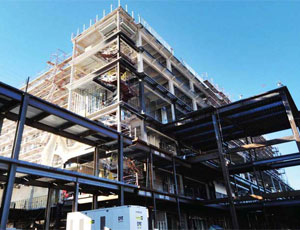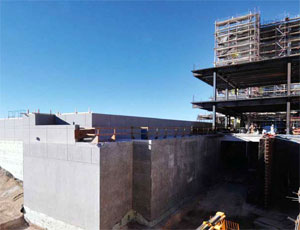The new $364.9-million hospital is the VA�s largest contract ever awarded.


...an MRI, PET scanner, x-ray, gamma cameras, dental, mental health, cardiology, prosthetics, audiology and geriatrics. Specialized components consist of three hyperbaric decompression chambers for respiratory patients, plus a computerized axial tomography (CAT) scan machine and other diagnostic equipment.
“Some of the challenges are the technical complexity of the work,” says JMA President Thomas Schoeman. “There are federal regulations and Americans with Disabilities Act requirements, as well as high-tech equipment.”
The hospital uses bright colors as a way-finding system to differentiate departments and services. The first floor has a 25-ft-tall grand lobby with skylights that act as the building’s spine. It’s the organizational center, or hub, from which other components radiate similar to bicycle wheel spokes.
The building’s uniform modular grid pattern allows independent module operation. There are 50 air handlers, for example, for zone climate control.
There are three main ground-level entrances with four-story-tall glass vestibules. One entrance is reserved specifically for ambulance traffic. The building, on 38.7 acres, is surrounded by a landscaped asphalt apron with 2,094 surface parking spots. Locally based Las Vegas Paving Corp. is the paving contractor.
The hospital is serviced by a two-level, 47,000-sq-ft central plant building with three boilers, four chillers, two cooling towers and five engine-generators. There are 285 mi of electrical conduit. Squeezing all the necessary ductwork, pipes and wiring overhead has required 12 ft of ceiling space in some instances.
“There is a lot more ductwork here than you would find in a normal office, with medical gas, air and added utilities,” Clark/Hunt JV project executive Phil Sloyan says. “We have been using 3-D coordination to figure out how to make it all fit. We have had to resize things as we go. It’s like a giant jigsaw puzzle.”
Yet the hospital still plans to finish by the end of 2011. It marks the fourth and final phase for the VA’s new 151-acre Southern Nevada medical campus. Other contracts consist of infrastructure site upgrades as well as a 120-bed, 100,000-sq-ft nursing home being design-built by Clark with Carter Burgess (now a unit of Pasadena-based Jacobs Engineering Group Inc.).
The new hospital supplements existing services for Nevada’s 246,000 veterans. VA operates 10 outpatient clinics in the state, four of them in the Las Vegas valley. It provided 5,467 inpatient admissions and 690,036 outpatient visits during fiscal year 2007.
“This construction project will ensure Nevada’s veterans continue to receive top-notch health care from VA,” says Gordon Mansfield who retired as VA deputy secretary last January. “This area has one of the fastest rates of population growth for veterans in the country.”
KEY PLAYERS
Owner: U.S. Department of Veteran’s Affairs
General Contractor: Clark Construction Group; Hunt Construction Group
Architect: RTKL Associates Inc.; JMA Architecture Studios
Engineers: Degenkolb; G.C. Wallace; Syska Hennessy Group
Subcontractors: Las Vegas Paving Corp.; Bergelectric; Bomel Construction Co.; Schuff International; Standard Drywall Inc.; Superior Mechanical; Alliance Mechanical Inc.; ISEC Inc.
USEFUL SOURCES
Visit the hospital’s website at www.lasvegas.va.gov


Post a comment to this article
Report Abusive Comment